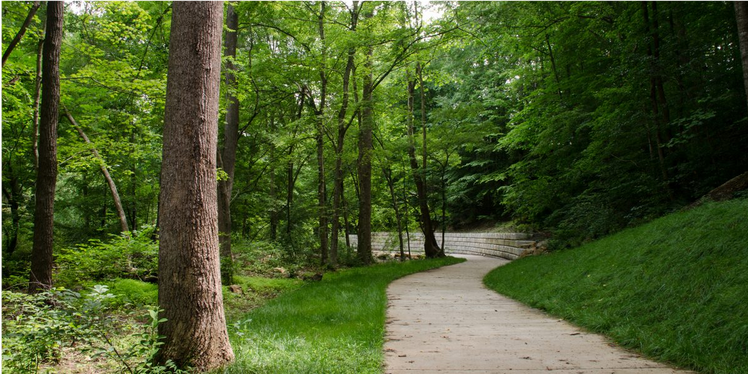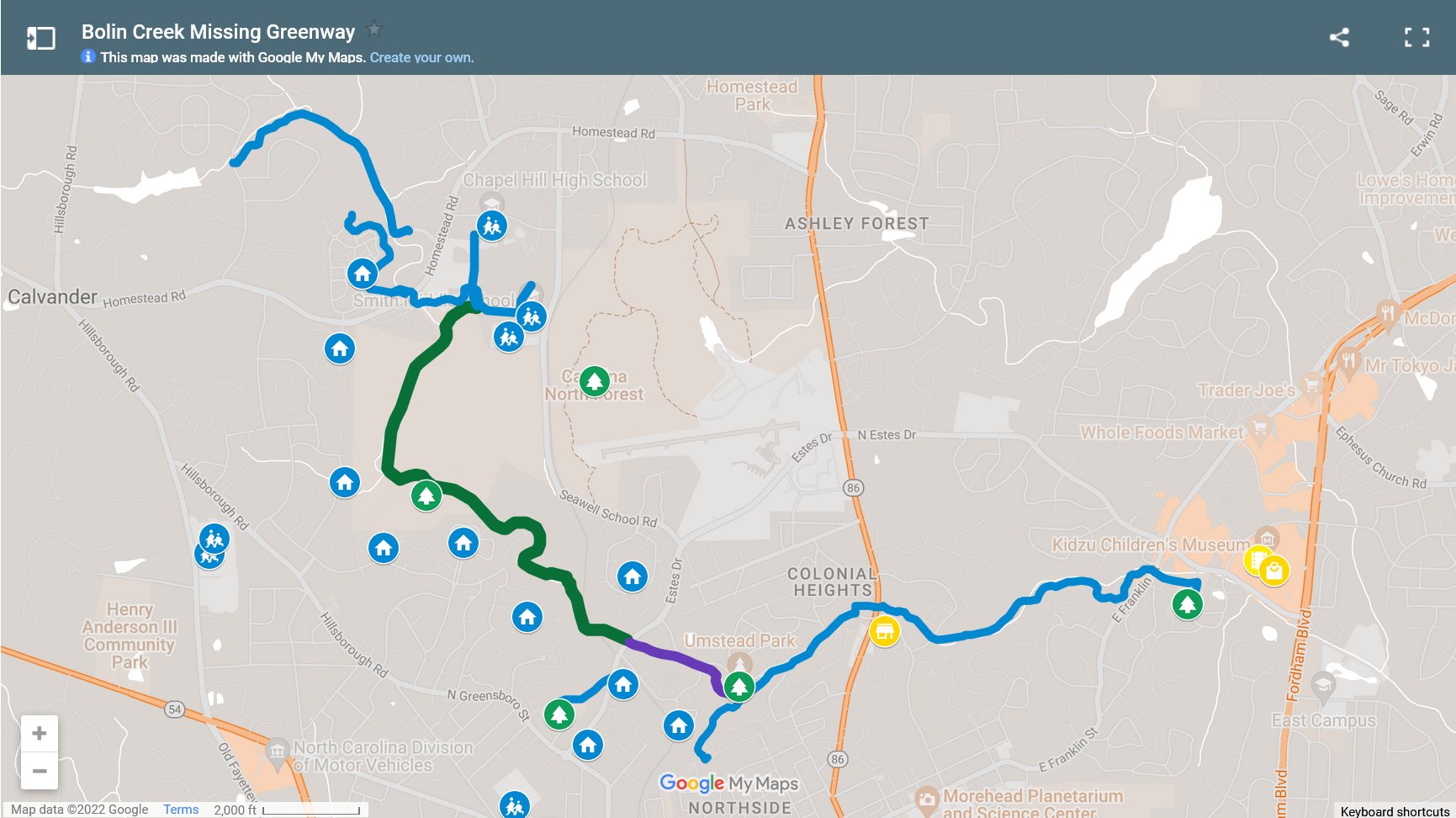You can sign up for updates to build out Carrboro’s missing greenway network on the Carrboro Linear Parks Project website.
Sometimes it feels like we’re living in a time loop, destined to rehash the same issues over and over again without ever making progress.
Imagine this: Nancy Pelosi’s the Speaker of the House, we’re approaching a recession, and a small group of people start banding together to block a paved greenway along Bolin Creek in Carrboro.
Is it 2022? Is it 2009?
Yes. And also yes.
As the Daily Tar Heel noted, NEXT recently launched the Carrboro Linear Parks Project to create a network of low-impact public trails across Carrboro. Basically, the project would make it easier and safer for walkers and bikers in many of Carrboro’s neighborhoods to get all the way to the Chapel Hill Public Library and University Mall and to several schools (Chapel Hill High School, Carrboro High School, Smith Middle School, Seawell Elementary, Morris Grove Elementary, and Northside Elementary). Hundreds of people use the Bolin Creek Greenway in Chapel Hill to bike, walk, and be close to nature. The “missing greenways” would help connect our schools, parks, and unpaved walking trails in Carrboro.
If you’ve ever walked along Bolin Creek in Chapel Hill by Community Center Park or by Umstead Park — it would be like that. But in Carrboro. (You can explore this interactive map — the new greenway would be what’s in green.)

Sounds Great! What happened in 2009?
Let’s go back in time….
Funds for the Bolin Creek and Morgan Creek greenways were included in a sidewalk bond referendum approved by Carrboro voters in 2003. In 2007, the Carrboro Board of Alderman set up a town greenways commission to study and plan for greenways along Morgan and Bolin Creeks. Public input was solicited repeatedly throughout the project.
By 2009, things were going well and the paved greenways were slated to be “finished by the end of the year….”barring unforeseen delays.”

Enter unforeseen delays (and dubious claims)
A contentious battle took place in Carrboro back in 2009 and 2010 over the greenway.
A group of people led by former Chapel Hill Town Council Member Julie McClintock — a leader in CHALT, the Alliance of Neighborhoods, Estes Neighbors, Affordable Transit for All (which worked to block light rail), the Booker Creek Alliance, Save Bolin Creek, and Friends of Bolin Creek — worked to block the greenway. Among their claims was that we would lose our pileated woodpeckers and wildflowers if we paved a 10-foot wide sidewalk path through the existing, cleared 30-foot OWASA corridor.
If you moved here since 2009 and have questioned how such a progressive place could be so reliant on cars to get nearly anywhere, these greenway opponents are a big part of the answer.
Dave Otto, the leader of Friends of Bolin Creek (until he was removed over supporting the greenway in Carrboro), noted back in 2010: “One of my neighbors, who lives in a prime creekside lot, candidly admitted his reason for opposing the greenway: classic NIMBYism; Don’t want a greenway in my backyard!”
He also wrote this: “The most common criticism from the anti-greenway faction is that an impervious surface in the riparian zone will increase runoff and degrade the quality of the creek. [They] are correct that compaction of the soil creates problems, but the surface of the OWASA roadway is already impervious, hardened by decades of use and abuse by heavy equipment to maintain the sewer line and by the relentless pounding of hikers, bikers and runners who use the roadway. Considerable sediment washes from the roadway whenever there is heavy rain. As a general rule, impervious surfaces should not be constructed in riparian corridors. Contrary to what opponents claim, construction of an impervious greenway in this case would actually stabilize the roadway, prevent abrading of land beside the roadway and reduce sedimentation of the creek.” (Emphasis ours). This is also what former OWASA board member Terri Buckner has pointed out on the blog Orange Politics.
Julie McClintock was quoted in the 2022 DTH piece stating the same vague environmental concerns, which were immediately disputed by the Director of Conservation Programs at the North Carolina Botanical Garden, who noted that there’s a strong argument for paving a greenway path to prevent runoff. This is consistent with what stream restoration experts say – there are environmental benefits to building paved greenways and next to streams with existing easements and informal, user-made “trails” on them.
Paved trails like the one in Chapel Hill are helpful because they help people stay on the trail which helps with erosion and runoff.
We know:
-
The birds and wildlife on Chapel Hill’s section of Bolin Creek have not been affected by the paved path in Chapel Hill. (The eBird counts show lots of warblers and woodpeckers.)
-
The Town of Chapel Hill has a greenway on the sewer easement along Bolin Creek between Umstead Park and Community Park, and there is no evidence that the creek has deteriorated as a result.
-
Bolin Creek has been impacted by decades of human activity. There are sewer manholes next to the creek, sewer pipes that carry wastewater across the creek, and the Bolin Forest HOA has built several play structures right up to the creek’s edge. Local landowner PH Craig clear-cut his large forested parcel bordering the creek. The trail along the creek is severely braided in some areas where trail users are avoiding puddles by going around them, widening the trail and encroaching further into the forest. A managed greenway would do more to preserve Bolin Creek than the current easement.

We’ve had a decade to evaluate the paved Bolin Creek Trail in Chapel Hill and….
The evidence is pretty clear: the erosion control and riprap installed alongside the greenway in Chapel Hill have not changed the health of Bolin Creek along that corridor. People are still spotting pileated woodpeckers along the paved trail.
And lots of people use the paved Bolin Creek path in Chapel Hill, where you can see dozens of people of all ages enjoying nature, getting their steps in, and even commuting via bike. It’s a great asset and resource for the town — and one Carrboro should have as well.
Paving the path will make it more accessible
A Carrboro resident was quoted back in 2010 as saying, “I have never been on the greenway because I cannot get there. If you expect me to go all the way to Chapel Hill, where it is paved, to access it, forget it. I want access to it in Carrboro.”
We do too. Walking the unpaved Bolin Creek Trail in Carrboro is pretty treacherous right now — there are rocks and large roots and unsteady paths on a good day; when it rains, it turns into a sticky, deep mud. That makes it hard for anyone in a wheelchair, biking to Chapel Hill High School or Smith Middle School, or anyone with a stroller to walk alongside the creek.
We want people using strollers and wheelchairs to be able to walk alongside the creek. We want our kids to be able to bike safely to high school. We want to be able to bike and not fear cars speeding alongside us, as is the case on many existing bike lanes in town. We want to not use our cars when making small trips where we could walk along a beautiful stream instead.
New opposition to the greenway, same as the old opposition to the greenway
Now we see history repeating itself.
With support for extending the greenways increasing, we’re starting to see Friends of Bolin Creek gearing up for a fight. They recently added several members of CHALT and Better Carrboro — a group that is trying to block affordable housing in Carrboro — to their conservation committee. Recently, a CHALT leader posted language on Facebook that indicated that they’re planning to block the paved greenway. The language they used overlapped with exact phrasing used 12 years ago by Friends of Bolin Creek.
They’re circulating a Conservation Guide for Bolin Creek, which was given to the Carrboro Connects Comprehensive Plan Steering Committee. It’s a document created by self-appointed guardians of the creek who admit they did not include any viewpoints other than their own. Based on the introduction and the table of contents, it views preservation of the creek in its current state as the only relevant goal. (There are many ways to preserve creeks! Including using greenways in linear parks to help manage stormwater!)
The report does not even pretend to consider that a 10-foot-wide paved trail through the already-cleared corridor would make the area remarkably more accessible and have overwhelmingly positive recreation and transportation impacts, especially for kids who want to bike or walk to Chapel Hill High School and Smith Middle School.
Since 2009, a very small group of greenway opponents have gotten their way by stalling progress and blocking the realization of broader community’s desires.
One of the many great things about Carrboro is that they survey their residents about what we want to see in town. And in the 2021 survey, where they surveyed over 500 households to reach a 95% level of confidence in the responses, you’ll find this in the Executive Summary:
Based on the sum of their top two choices, the transportation services that residents thought were most important were: 1) ease of walking in Carrboro, 2) availability of greenways/multi-use paths, and 3) ease of driving in Carrboro.”
As the Carrboro Linear Parks Project brings this discussion back into the limelight with a forward-looking vision of an inclusive, greener, transportation system, we’re going to hear the same small group of people trot out the same tired arguments used in 2009.
But our town has good data on what Carrboro residents want, and we want multi-use paths that help us get safely to Chapel Hill and school and the library.
We call on the Carrboro Mayor and Town Council to lead a discussion that doesn’t simply empower the same small group of people who have killed Carrboro’s progress on its top priorities through a series of rehashed 3-minute speeches at Town Hall this time, and build a greener and more connected Carrboro.
